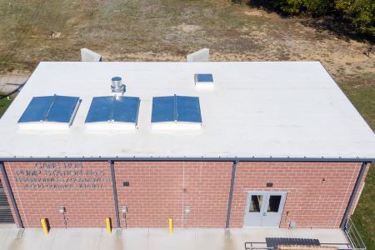Indiana Communities Hope Rebuilt Pump Station Dries Up Regional Flooding Problems
By Thomas Renner

Two Indiana communities nestled along the Ohio River hope a new $6 million pump station will alleviate the region’s flooding woes. Relief was certainly long overdue.
Jeffersonville and Clarksville, located in southern Indiana near the Kentucky border, faced flooding issues for decades. The Cane Run pump station had been operational for more than 70 years but had been underperforming for years.
The Army Corps of Engineers recommended an upgrade to the pump station in the 1960s, but flooding seemed to be growing in intensity and frequency over time. Businesses and homeowners near the river suffered more than $1 million in damages when flooding occurred in 2011 and 2015.
The creation of the Clarksville-Jeffersonville Flood Control District in 2017 put plans for a new pump station in high gear. The project was approved in 2019 and became operational in August.
“We’ve been talking about this project for about 10 years or more,” said John Buckwalter, superintendent of the Jeffersonville-Clarksville Flood Control District. “The existing pump station just couldn’t keep up with the capacity that was required.”
Pump Station Failures
Flooding occurs when the Ohio River reaches elevated levels after heavy rainfall. When the water level in Cane Run Creek Basin exceeds 427 feet, water backs up and causes flooding in Colgate Park and some nearby parking lots. Overflows occur an average of 22 times every six months, according to the Indiana Department of Environmental management.
“The issue is that the pump station does not come on until there’s already been significant flooding and Colgate Park is under water,’’ Town Council President Paul Fetter told the Courier Journal. “Before the pump station is even running at full capacity, we have five feet of water between the Clarion Hotel and Derby Dinner Playhouse and another five to six feet in Colgate Park.”
Funding for the project became hard to resolve. Since the pump station serves two communities, the approval process also required extensive time to sort out. The agreement called for the city of Jeffersonville, the town of Clarksville and the Jeffersonville Flood Control District to each contribute $2 million to finance the project.
Significant Pump Upgrade
The new pump station includes three 250-horsepower vertical turbine pumps that can pump 16,000 gallons per minute. The previous facility pumped 28 cubic feet per second, while the new station has an output of 58 cubic feet per second. The project also includes the installation of three 30-inch diameter ductile force main discharge pipes, each at 700 linear feet, with a common outfall structure.
Two sump pumps with 1 CFS for dewatering were included, along with a manual bar screen with 2-inch openings. Construction teams built an electrical building adjacent to the pump station, installed an emergency generator and paved a new access drive to the station.
“With three pumps running at 100%, we can drop the water level by a foot pretty quickly,” Buckwalter said. “Even with two of the pumps we should be able to handle a significant rain event.”
The station will send water to a 16-acre ponding area. The area takes about a month to fill during non-rain events and is located between the flood wall and the northwest corner of a nearby park. Homes and businesses in the area are not impacted by water that is sent to the ponding area.
Lochmueller Group of Indiana served as the engineering firm for the project while Thieneman Construction served as the contractor.
Accessing Equipment
The project includes access and safety products from BILCO, the manufacturer of specialty access products.
Three roof hatches allow access to the vertical turbine pumps and two floor doors lead to a lower trough. A LadderUP safety post from BILCO is also included in the building. Midwest Metal Works provided the doors for the project through BILCO’s distributor in the region, Welling Inc.
“We know the BILCO products are good and Thieneman was able to get them at a good price,” Buckwalter said.
BILCO products are selected for many projects related to the water industry due to the corrosion resistant materials, which ensure years of dependable service. They are also engineered with compression spring operators to provide one-hand operation and automatic hold-open arms that lock the covers in the open position to ensure safe egress.
A History Of Flooding
In 1937, the Great Flood left Clarksville submerged in as much as 12 feet of water. The same flood, which dropped 15 inches of rain in a 12-day span, left 90% of Jeffersonville submerged. The Ohio River stretched out 10 miles wide and regional flooding caused an estimated $3.3 billion in today’s dollars.
Most of the flooding in the region occurs during the first half of the year. Buckwalter believes they have built a solution that will serve the community well for a long time.
“We’re confident we’re not going to be overwhelmed anymore,” Buckwalter said. “Flooding doesn’t happen often, but we’re happy that we have a solution that will benefit both communities.”
Thomas Renner writes on building, construction, and other trade industry topics for publications throughout the United States.
